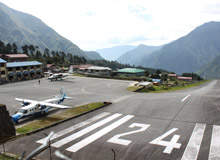

Tenzing-Hillary Airport, Nepal
Tenzing-Hillary Airport, also known as Lukla Airport, located in the town of Lukla, Nepal, has a tiny runway surrounded by precipitous mountains at an elevation of 2,860m. The airport also has a 460m long paved asphalt runway with a gradient of 12%, which handles only helicopters and small, fixed-wing, short-takeoff-and-landing (STOL) aircraft.
The airport remains closed in high wind and poor visibility conditions, but unpredictable weather still poses a significant risk to those aircraft already airborne. Nine aircraft crashed or collapsed near the airport between 1991 and 2013.
Toncontín International Airport, Honduras
Toncontín International Airport located 6km away from Tegucigalpa, the capital of Honduras, has the world’s most difficult approach to the runway, which is dangerous particularly in harsh weather conditions. The single asphalt runway at the airport is 2,021m long.
Toncontín airport witnessed 10 accidents since its inauguration, the worst was in 2008 when a TACA Airlines Airbus A320 overran the runway on a rainy day, killing five onboard and two on the ground.

Paro Airport, Bhutan
Paro Airport, the only airport in Bhutan, is one of the most dangerous in the world as it lies at an altitude of 2,225m and is surrounded by the steep mountains of the Himalayas. The 1,985m long runway is shorter than the airport’s elevation above sea level. The airport is one of the world’s most challenging for take-offs and landings.
Only a few pilots in the world are certified to land at the airport and flights are permitted only in day time under visual meteorological conditions.
Gustav III Airport, St Barthélemy
Gustaf III Airport, also known as Saint Barthélemy Airport, located in St. Jean on the Caribbean island of Saint Barthélemy, has a short runway at the base of a gentle slope with hill on one end and a beach on other end, making landings and take-offs extremely difficult. The airport is also prone to very high winds.
The short concrete runway of just 650m length handles small regional commercial aircraft and charters carrying 20 or fewer passengers.

Juancho E. Yrausquin Airport, Saba
Juancho E. Yrausquin Airport located on the Caribbean island of Saba has the world’s shortest commercial runway making the touch downs and lift-offs tough for even experienced pilots.
The runway at the airport is just 396m long with high hills on one side and its either ends extending towards cliffs that fall into the sea. It handles smaller fixed wing aircraft as well as helicopters and allows landing on both ends depending upon the wind conditions.
Courchevel Airport (Altiport de Courchevel)
Factors such as difficult approach, an upslope runway and a neighbourhood peppered with ski runs make flight operations at Courchevel Airport (Altiport de Courchevel), situated in a skiing area of the French Alps Mountains.
The airport’s 525m-long short runway with a gradient of 18.5% handles smaller fixed-wing aircraft as well as helicopters. The runway lacks instrument approach procedures, thus touchdown in fog and low clouds is nearly impossible. A go-around procedure is common at the airport and night flights are banned.

Princess Juliana International Airport, St Martin
Princess Juliana International Airport, also referred to as St. Maarten International Airport, located on the island of Saint Martin, has low-altitude flyovers as one side of its runway is quite close to the shore and Maho Beach.
Pilots approaching the 2,300m long runway at need to maintain extreme situational awareness to avoid errors during low-altitude flyovers over the beach, while they also need to turn to avoid mountains on take-off.
Madeira Airport, Madeira Archipelago
Madeira Airport’s runway rests on columns built on the area surrounded by high mountains and the ocean. Despite the runway’s extension, only specially trained pilots are allowed to land or take-off at the airport. Aircraft accessing the airport need to take clockwise approach to land on the runway.
The airport serves Funchal, the capital of Portuguese archipelago of the Madeira, and handles scheduled flights to and from 10 European destinations.

Barra Airport, Scotland
Barra Airport, well known for its beauty, is located at the north tip of the island of Barra in Scotland. It features the world’s only beach runway offering scheduled flight services.
The airport implements special procedures to assure the safety of flights, which include no public access to the beach when the airport wind sock is flying. The air traffic control tower illuminates a strobe light to indicate aircraft movements. Pilots flying from/to the airport must deal with irregular sea tides while taking off and landing as the runway is swamped at high tide.



